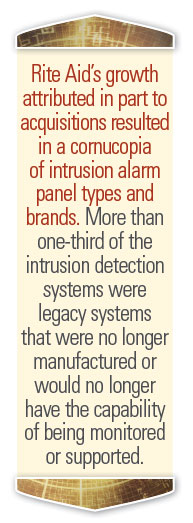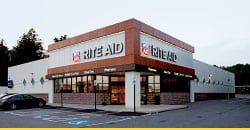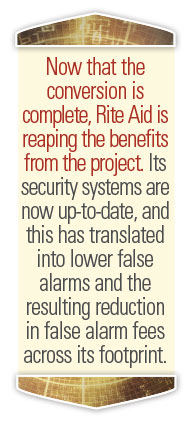Headquartered in Camp Hill, Pennsylvania, Rite Aid is the third-largest drugstore chain in the United States. It operates nearly 4,600 stores in 31 states and the District of Columbia and employs more than 89,000 associates. The retailer recently embarked on a project to convert many of its locations into Wellness Stores as part of its continuing transformation into a growing, retail healthcare company.
The drugstore chain grew in part through acquisitions resulting in diverse security platforms and system configurations with multiple product manufacturers. When Rite Aid set out to convert its outdated intrusion retail alarm systems in all of its locations, Rite Aid’s Group Vice President of Asset Protection Bob Oberosler and his team knew it would be a challenging project.
“We recognized the fact that over the footprint of our organization, we had as many as 10 to 12 different alarm panels, many of which were obsolete and no longer supported by the manufacturer and at risk of not being actively monitored,” stated Oberosler. “Because we are a highly regulated industry, if the alarm systems failed, that would mean we could not operate our pharmacies without deploying guard services. We knew we had to upgrade and standardize our approach, and we needed to do it soon.”
The drugstore industry has stringent guidelines and regulations in place as it relates to security systems. Some states’ boards of pharmacy will not allow a pharmacy to operate without a working security system. This industry is not only responsible for the safety and security of its customers and employees, it must also safeguard high-demand, high-dollar controlled substances and confidential information, including patient medical records, prescription histories, credit card numbers, and insurance information. Furthering the demand on the security systems, the pharmacies are often targets of burglaries and robberies.

The competitive retail environment posed an added complexity to this large-scale, physical-security project. Drawing customers into the stores and providing a positive customer experience needed to be maintained while executing a quick and seamless conversion of the systems.
Rite Aid’s growth attributed in part to acquisitions resulted in a cornucopia of intrusion alarm panel types and brands. More than one-third of the intrusion detection systems were legacy systems that were no longer manufactured or would no longer have the capability of being monitored or supported.
With the drugstore chain’s large footprint and accelerated installation timelines, the asset protection team needed a partner who could provide them with a strategy to accomplish this without sacrificing quality and customer experience.
The Six-Month Challenge
With the objective of undertaking this nationwide conversion program to suit both immediate and long-term needs, Rite Aid engaged Protection 1  Security Services. Prior to executing the contract, Oberosler and his team held numerous meetings with the solution provider’s executive staff and team members from all parts of the organization to fully vet the project and agree on an execution plan.
Security Services. Prior to executing the contract, Oberosler and his team held numerous meetings with the solution provider’s executive staff and team members from all parts of the organization to fully vet the project and agree on an execution plan.
“The executive staff, including CEO Tim Whall, took the time to personally meet with me and my team to fully understand our goals and our technology roadmap for the future,” said Oberosler. “They made a commitment to being a partner and building a program that could capitalize on the technology that our asset protection team was investing in.”
Oberosler’s goal was to complete the conversion in a timeframe of six months, within budget, and with no disruption to store operations.
“I needed this project done as quickly as possible to minimize the impact on our stores,” stated Oberosler. “That is when I put forth the challenge—or more succinctly, the requirement—to complete the conversion in six months.”
A project of this magnitude would typically take upwards of twelve months’ time, but in order for the stores to maintain active monitored systems, the timeline needed to be cut in half. Once the two companies reached an agreement, both acknowledged they would have to define a different approach in order to support the project from an installation and deployment perspective to complete the conversion in the timeframe defined by Rite Aid.
Jim Shepherd, Protection 1’s national account manager, said, “We knew we would have to do something different in our approach in order to meet the deadline and maintain the level of service committed to Rite Aid.”
Expect the Unexpected
While the immediate concern was ensuring all retail alarm systems were operable and current, the security team also considered future needs. If they could stretch the operating budget expenditure to provide future scalability and the capability to integrate other systems, that would be an important incremental benefit.
 Completing the conversion without any disruption to store operations and processes was of utmost concern to Rite Aid. Store employees needed to focus on servicing customers, and work being done on the premises could have served as a distraction.
Completing the conversion without any disruption to store operations and processes was of utmost concern to Rite Aid. Store employees needed to focus on servicing customers, and work being done on the premises could have served as a distraction.
As the project commenced, Oberosler identified a number of challenges or complexities that the team would have to take into consideration and overcome. These complexities are important factors that any loss prevention executive should take into consideration when taking on a transition of technology of this magnitude in a short amount of time. Oberosler’s message to his fellow LP colleagues was simple—”Expect the unexpected.”
The first step in the process was to categorize the conversion into three parts:
• Those stores that could be reprogrammed electronically,
• Those that needed their keypads and panels changed out by an on-site technician, and
• Those locations that needed a total replacement.
Adding to the first set of complexities, due to the age of some of the retail alarm systems, the master codes to reprogram the panels were no longer  available. This required a more complex approach.
available. This required a more complex approach.
The next priority was to upgrade approximately 500 stores that were running on an outdated server that was at risk of failure. If the servers failed, those locations would not have a working security system and would not be able to operate without a manned guard service. The installation team had a forty-five-day window to complete the conversion in these stores.
Inception of the Seal Team
Quality, consistency, and speed were key factors in the success of the conversion. Protection 1 decided to train a designated group of experienced technicians to execute the Rite Aid project. It recognized that in order to accomplish the installation in nearly 4,600 locations in a six-month window and, more importantly, convert the approximately 500 at-risk locations in 45 days, a different approach would be required to be successful.
This group was given the name “Seal Team” in recognition of the need to be quick, efficient, and mobile to accomplish the task. The installation team was brought together and trained specifically on all Rite Aid profiles so it could deliver an installation experience that was uniform across Rite Aid’s footprint.
The Seal Team was furnished with a new fleet of trucks to support the rapid mobility from city-to-city and state-to-state. To meet the needs of Rite Aid, the team was able to deploy quickly to any area, at any time, oftentimes working on weekends and odd hours. This unique operation essentially gave Rite Aid a dedicated installation technician team, tailored to meet the needs of the project.
Retail Alarm System Implementation
Customization became a common recurring theme during every step of the project. Rite Aid required a comprehensive strategic plan for the conversion that included constant communication and personalized execution to ensure the project would be completed on time and within budget.
 Training. Once the Seal Team was chosen, it traveled to Detroit where a high concentration of Rite Aid stores existed, to undergo intensive training and preparation for the project. The team learned about every existing legacy alarm model that it would encounter, how to reprogram the systems, and how to ensure they would integrate with other existing systems, such as lighting, HVAC, and fire systems.
Training. Once the Seal Team was chosen, it traveled to Detroit where a high concentration of Rite Aid stores existed, to undergo intensive training and preparation for the project. The team learned about every existing legacy alarm model that it would encounter, how to reprogram the systems, and how to ensure they would integrate with other existing systems, such as lighting, HVAC, and fire systems.
At the same time the conversions would be taking place, Rite Aid was remodeling several stores to feature its new Wellness Stores format, which included investments in new technology that would have to integrate with the retail alarm systems. This would require the Seal Team to have a good grasp of the dynamics of each location so that the end result was a fully integrated system. Hands-on training allowed the team members to model the work that would be required to be performed in the stores.
Conversion. A test team was deployed to Kentucky to complete 28 sites. After a successful run, the remainder of the team was initiated, and over 500 sites were converted in the first month.
During the inspection process, the Seal Team found that some stores’ systems did not require replacement as initially presumed. Some existing panels had the capability to be reprogrammed, so only a fraction of the alarm systems required full replacement. At these sites, the installation technicians performed the reprogramming work, helping Rite Aid avoid unnecessary system replacement and realize cost savings to the bottom line.
Customization. Each system was customized to meet the needs of the individual store, requiring additional programming and technical work from the Seal Team. Some systems had multiple communication paths for the intrusion system. Because a majority of stores participate in a green program, which negotiates lower electric bills for stores that have lighting controls activated with arming and disarming of the retail alarm system, the intrusion-detection systems also required integration with the lighting systems.
“We chose a Digital Monitoring Products (DMP) solution for stores that required an alarm-panel replacement,” explained Shepherd. “We worked with the manufacturer to customize the panel to provide a number of personalized capabilities, including the capability of PIN-code management via an online data management portal application.”
This online portal allows Rite Aid to manage security data for all of their stores, such as viewing open/close schedules and reports, viewing incidents and alarm activity, and running custom exception reports.
Rite Aid deploys separate alarm panels in its pharmacy suite. The pharmacy often operates hours independent from the store (for example, closing at  an earlier time). Rite Aid needed to have the ability to activate the alarm in the pharmacy without turning off store lighting. This problem was solved by working with DMP to customize the panel software and design a system that could arm the pharmacy alarm independent from lighting controls.
an earlier time). Rite Aid needed to have the ability to activate the alarm in the pharmacy without turning off store lighting. This problem was solved by working with DMP to customize the panel software and design a system that could arm the pharmacy alarm independent from lighting controls.
As the conversions proceeded, Oberosler added additional requirements to the project. While the stores were being converted, he wanted to review the retail alarm system history at each location for false-alarm activity and fines. This information gave the installation team an opportunity to change the basic layout of the systems to improve performance.
“We also found along the way, that in most locations, we lacked documentation or diagrams for the existing systems, further adding to the complexities of the project,” noted Oberosler, “As the team continued with the installations, they were also generating the documentation for each location such as users guides and operating procedures for future use.”
Constant Communication. A key reason the project was successful was the constant and proactive communication. Protection 1 assigned dedicated project team members at their National Account Operations Center (NAOC) in Dallas to communicate daily with the Seal Team to receive project status updates, timely plan subsequent store conversions, and resolve issues. This center was created specifically to support large, complex deployments for national customers.
“One of my top priorities was weekly status meetings between the implementation team and the key stakeholders from Rite Aid,” said Oberosler. “This was not just an asset protection project, but one that touched many different factions of our company. We needed to make sure we had clear communications between areas that ranged from our network staff to field and store managers.”
 During the calls, the two teams would go through a detailed check list of action items that needed to be addressed.
During the calls, the two teams would go through a detailed check list of action items that needed to be addressed.
“I also received an updated project management report on my desk every morning that provided me with a detailed status of the roll-out up to three weeks out,” continued Oberosler. “There were a few stumbles at the beginning, but the bugs were quickly worked out, and at any given day I knew exactly where we were in the process.”
Rapid Progress Yields Results
After just the first month, the installation team was able to covert over 500 sites. The peak number of retail alarm systems converted in one month reached 740. Within four months, over 2,000 sites were completed. As of January 31, 2014, a total of nearly 4,500 store conversions had been completed and are actively monitored. More than 380 stores that were originally classified as locations that could not be converted due to outdated technology were also updated with new equipment in the conversion. The project was completed and delivered within the budget and timelines promised.
“With the size, scope, and timelines of the project, we had to get creative to ensure we met expectations. It was a good experience for all of us involved that really expanded our thinking in how to approach such large-scale conversions in the future,” observed Brenden Smith, Protection 1’s vice president of customer installation.
“I was pleased with the efforts of everyone involved in the conversion, including my team who really stepped up to the plate to make this happen. I have no reference, but I certainly feel that this conversion was done better than any other in the history of the alarm industry,” said Oberosler. “Not only was the project done on time, but it actually came in under budget even with the added layers of complexities that were discovered as the project evolved. To sum it up, the installation team won the Super Bowl of conversions.”
Future Improvements
At the outset of the project, while the immediate concern for Rite Aid was ensuring all intrusion systems were operable and current, the security team also wanted the new systems to be scalable, to accommodate the retailer’s future needs beyond retail alarm systems.
Shepherd explained, “Because we planned for the capability of integrating with systems, such as video and access control, Rite Aid has the potential to realize further benefits, such as protection against internal theft and inventory shrinkage, as well as making progress towards thwarting organized retail crime.
 “We are working with Rite Aid to beta test a video integration project that would allow a central station operator to ‘voice down’ or communicate with the premises remotely, which could help a retailer mitigate losses, reduce shrinkage, and enhance ROI for the overall security investment,” Shepherd said.
“We are working with Rite Aid to beta test a video integration project that would allow a central station operator to ‘voice down’ or communicate with the premises remotely, which could help a retailer mitigate losses, reduce shrinkage, and enhance ROI for the overall security investment,” Shepherd said.
“The project went way beyond a ‘simple’ upgrade of our electronic security system. Now we have the foundation to integrate new technologies such as remote monitoring, temperature control on an enterprise level, and integration of our camera technology,” added Oberosler.
The Results
Now that the conversion is complete, Rite Aid is reaping the benefits from the project. Its security systems are now up-to-date, and this has translated into lower false alarms and the resulting reduction in false alarm fees across its footprint.
Because the systems are more uniform, the data extracted can be used across a number of departments and projects. Common occurrences in the drugstore industry are audits from outside agencies, including state pharmacy boards and other government agencies. With consistent reporting capabilities, Rite Aid is able to quickly access information from the security system that provides detailed accounts of what occurred should a question arise during the review period. Administering the new security system also provides Rite Aid with cost savings through reduced labor and associated costs.
But perhaps the biggest benefit is the ability to provide a safe, secure, and protected environment for Rite Aid’s customers and associates.
This article was originally published in 2015 and was updated February 22, 2016.


